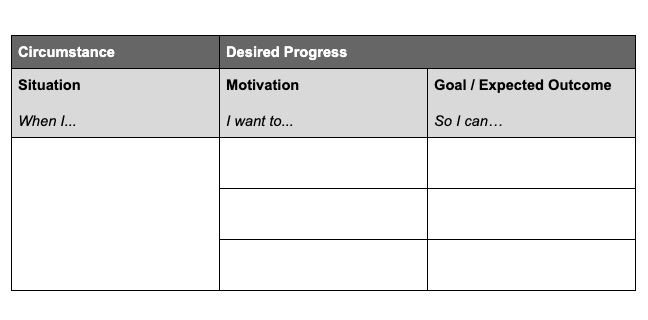Brand Positioning Strategy And Framework
How to define your brand positioning strategy based on your customers’ needs, competitive points of differentiation, and alignment of your brand’s offerings.

Our Content Is Featured In:

Join 6,538 folks who receive our latest insights and you'll get immediate access to our 10 page brand strategy workbook!
Instantly analyze your brand
Use our new positioning app, SmokeLadder, to see where your B2B brand is strong, weak, and where it can stand out from the competition.
What Is Brand Positioning?
Brand Positioning Definition
Positioning speaks to how a brand communicates its unique value in a way customers can easily understand.
To make that communication effective and memorable, your position needs to convey some specific points of information. Your customers want:
- Context: What part of my life does this relate to?
- Points of Differentiation: Why is this particular solution valuable for me?
- Proof Points: How do I know this will deliver on my needs?

To get that information, we need to dive deep into 3 core areas of your brand:
- Customers: What motivates them and what needs do they hope to satisfy?
- Competition: Where does your brand sit within the competitive landscape?
- Offering: How does your product or service align with the needs of your customers?
Understanding each of these elements on their own is a critical first step, but you can’t stop there. A real brand positioning strategy speaks to how all of the 3 elements work together.
The challenge of course is that you need to break down the elements in a systematic way. The sections below provide some frameworks and exercises from our positioning process to help you get started.
Brand Positioning Framework
Step 1: Understand Your Customers
Your positioning strategy should always start with your customers. It’s very easy to fall into the trap of thinking about your position strictly from the perspective of your product or service, but you can’t communicate effectively with your customers if you don’t deeply understand their needs first.
Below are two frameworks you can use to break down the motivations of your customers.
Jobs to Be Done:
The Jobs to Be Done framework helps us think about the challenges our customers are looking to solve in their lives. Some of these challenges are functional (i.e. I need to save time with a task), some are emotional (i.e. I feel anxiety when I’m juggling too many things), and some are aspirational (i.e. When I solve my tasks consistently it gives me hope that my business can scale).
By talking to and listening to our customers we can uncover these Jobs to Be Done and then speak to them through our brand positioning.
We have an entire resource section with exercises to help you get started.
This is our Job Story exercise template. For additional exercises and to learn how to use them with your brand, go to our complete Jobs to Be Done resource section.

Elements of Value:
With our customer Jobs defined, we can use the Elements of Value framework to get even more specific about the needs of our customers.
The Elements of Value are like the periodic table of things customers care about when making a buying decision. Once again, we see there are tiers of elements ranging from functional, to emotional, to aspirational.
Our goal here is to look at the Jobs our customers have and identify the elements that most align with those needs.
We have an article and video on the Elements of Value to help you get started.
This is the B2C version of the Elements of Value (there’s a B2B version as well) to help you visualize the elements together. Watch our video to learn more about how you can use this framework with your brand.
Step 2: Differentiate From The Competition
Once you understand what’s driving your customers and what they want in a solution, you can compare and contrast your brand with the competition to find areas of strength (and weakness!).
Below are two ways to visualize the differences between your brand and your competitors.
Competitive Landscape:
Before you can evaluate your brand in the competitive landscape, you need to determine the category you’re competing within. Once again, this is less about how you see your brand and more about how your customers see it.
By focusing on how your customers see their own challenges and what other solutions they may consider, this will help you define the market and the offerings you’re competing against from their perspective.
With the market context in mind, you can compare and contrast differences between brands by grading their strengths and weaknesses. This is where the Elements of Value come back into play. Once you have the elements that your customers care about, you can assign values to each element based on how well you satisfy it and how well your competitors satisfy it.
To start you can assign these values based on existing market knowledge, research, and data. It can then be refined with customer survey and interviews.
With those grades in place, then you can visualize the results to understand where your brand fits in the landscape compared to competitors.
We use two visualization tools to identify relative strengths and weaknesses and we have additional resources for each one:
- Brand Positioning Map: Creates a high level overview of comparison
- Strategy Canvas: Visualizes specific points of strength and weakness
With a brand positioning map (see, the example below for Masterclass), we can see on a high level the relative position of brands within a market. This is helpful to communicate comparisons on a broad level.
Read our article on how to plot competitors via a brand positioning map.
The Strategy Canvas (see, the example below for AirBnb) is a great tool for looking at the specific points of difference between your brand and competitive solutions.
Read our article on how to plot competitors via a Strategy Canvas
Step 3: Align Your Offering
Finally, you need to ensure that your brand’s offerings (i.e. products, services) align with the needs of your customers and deliver consistent value on those points of differentiation.
Below are two exercises to help you map alignment with your brand’s offering.
Map Offering Alignment:
To help see how well your offerings align with the needs of your customers, you need to break them down down into discrete pieces.
We do this by first looking at the offering as a whole and then the specific features and attributes within that.
This allows you to see exactly how those features and attributes contribute to the value your customers are seeking. It also helps you to see your brand’s balance between standard or “table stakes” features (i.e. baseline elements you need to compete in the space), versus true highlights that align with clear points of differentiation.
Looking at your offering through this lens not only shows how well aligned your brand is it can help trigger new innovation as you pinpoint areas of opportunity for new features or totally new offerings.
Brand Positioning Statement
A positioning statement serves as a short summary of the key elements of your brand positioning strategy. It’s an internal-facing tool that can be used to help align your marketing and sales team on your brand’s most critical points of value for different audiences.
Your team can and should have multiple variations of positioning statements based on the most critical points you want to emphasize for each of your target customers.
The trap that people often fall into though is thinking they can simply fill out a positioning statement outline without doing the work it takes to define and understand the inputs for it.
So, while using a positioning statement structure (like the example here) can serve as a helpful shorthand reminder for your team, it’s not a process for defining your brand’s positioning strategy.
You have to do the work to dig into the 3 core areas of your positioning in order for a positioning statement to have any value.
We intentionally placed this section at the end to emphasize that filling in your positioning statement is the very last step in the process.
Reviewing the positioning examples we have for Lyft and Chipotle shows how these different elements fit together.
Brand Positioning Statement template:

Brand Positioning Statement examples for Lyft and Chipotle:

Brand Positioning Examples
Brand Positioning Questions
Here are 6 questions to consider as you evaluate the strength of your Brand Positioning Strategy:
- Is your location in the competitive space open or crowded? Are there clusters where groups of competitors are trying to meet the same needs in the same ways? Why?
- How would the competitive landscape look different if you chose different Customer Jobs to Be Done? Are there other Jobs that your brand can satisfy that are less competitive or that you have more advantages in serving?
- What if you expanded / restricted your existing competitive context, or choose a different space altogether? Would you be able to differentiate your brand more effectively if you were competing with different brands and offerings?
- What if your Customers’ Elements of Value were different? (e.g. Fun / Entertainment actually turned out to be more important than Saves Time or Reduces Cost)? Have you validated that the Elements of Value you believe are most important align with what your customers think?
- How well are you satisfying the features you believe to be most important to your Customers? Do you have an opportunity to invest further in areas where you have a competitive advantage?
- Which features are most associated with competitive challenges? Are these areas where you currently invest significant resources? Could those resources be better allocated to areas of opportunity?
Get Help Crafting Your Brand Positioning Strategy

Free Brand & Marketing Workbook
Get immediate access to our 10 page workbook to help you define your Core Purpose, Vision, and Core Values, along with resources for Brand Archetypes, Tone of Voice, Messaging, and more!

Hands-on Brand Strategy Help
Transform your best business thinking into an actionable, shareable, growth-oriented guide. Click below to learn about the Brand Guidebook process.












